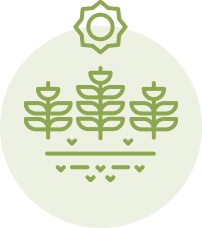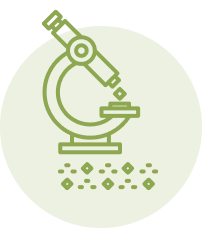The Earth Science approach to lawn care is designed for simplicity and efficiency in creating attractive, vigorous, and healthy lawns. Our methods of smart lawn care allow people to spend less time maintaining a lawn and more time enjoying it. It also reduces the potential negative environmental impact of a lawn.
Proper lawn culture is an effective preventative for the most common lawn problems. A healthy, vigorously growing lawn is naturally resistant to pest, disease, and weed problems. Proper management of mowing, watering, and fertilizing are the keys to good lawn culture.
The Keys to Proper Mowing
Mowing properly is critical to having a healthy, vigorous lawn. Improper mowing stresses grass and makes a lawn more prone to weed problems, disease, and bare spots. Properly mowed lawns produce deep, vigorous root systems that are better able to absorb water and nutrients and more resistant to environmental stresses, pests, and weed problems.
There are two keys to proper mowing. They are:
- the height of the grass after mowing and
- the length of the leaf blades removed when mowing.
All types of lawns should be mowed so that no more than one third of the total leaf blade length is removed in a single mowing. Height after mowing varies with the type of grass grown. Lawns with cool season grasses are best mowed to a height of 2 ½ to 3 inches minimum. Warm season grass heights after mowing should generally be 2 to 2 ½ inches tall.
In shaded areas, the tallest recommended mowing height should be used. Grass growth tends to be more upright in nature in shaded sites, so using the higher mow height helps promote good light accumulation in shaded sites.
Lawns may need mowing every 5 to 7 days during active growth periods. During periods of slower growth or dormant periods, mowing may only be needed every 1 to 2 weeks.
Lawn mower maintenance is also an important part of proper mowing. Sharp mower blades cut grass blades cleanly, and clean cuts are less stressful to lawns.
Utilize Lawn Clippings
Clippings break down rapidly when lawns are mowed properly. Allowing clippings to remain on lawns to decompose provides nutrients and organic matter to the soil as the clippings break down. This can be very beneficial to lawn and soil health and reduce the amount of fertilizer lawns require. Clippings have a high water content (generally 70 to 85% moisture), so they dehydrate rapidly and do not leave a large amount of residue on the surface of the lawn as they break down, as long as mowing is done properly. Clippings will not contribute to a buildup of lawn thatch.
Grass clippings typically contain about 4 percent nitrogen, 1 percent phosphorus, and 2 percent potassium, plus small amounts of other plant nutrients. Leaving clippings on the lawn reduces the need for fertilizer inputs and makes fertilizer applications more efficient. Up to half of the nitrogen applied as fertilizer may be lost when grass clippings are removed, and research at the University of Missouri shows that not removing grass clippings can reduce a lawn’s overall fertilizer needs by about 25 percent.
Watering
Proper irrigation is a key to optimal lawn care. Both the timing of irrigation and the amount of water applied are the key factors in proper lawn watering. Water during morning hours (before 10 AM) to reduce water loss through evaporation. Avoid watering in the evenings, as wet grass during nighttime hours can promote disease infection.
In general, lawns require 1 inch of water per week during the growing season. In weeks where rainfall provides an inch of water, additional irrigation is not needed. Water enough to wet the soil deeply and avoid more frequent, light waterings. Regular light watering can reduce root growth and make grass less drought tolerant. When irrigation is needed, water lawns one to two times in a week.
Note that lawn browning during periods of severe heat and drought is normal. This is a lawn’s response to heat and moisture stress, naturally ceasing growth and entering a period of dormancy. Lawns can typically tolerate up to a month of dormancy, returning to active growth when drought
Fertilization
Proper lawn fertilizing involves choosing the right product and applying it at the right time and right rate. When to fertilize depends in part on the type of grass used in a lawn.
Fall is generally the most important time to fertilize cool season grasses. Fertilizing in spring, once growth resumes, is also acceptable. If just one fertilizer application is to be made in a year, use a fall application.
Warm season grasses are best fertilized in late spring to early summer, when temperatures warm up enough for them to resume growing. Typically 1 or 2 fertilizer applications are made in each fertilizer window. Fertilizing when grass is not growing actively leads to less efficient nutrient uptake and increases the potential for nutrient loss in runoff.
We recommend applying no more than 0.8 pounds of nitrogen per 1,000 ft2 of lawn with any single fertilizer application. Applying too much fertilizer (over-fertilization) is wasteful and can lead to loss of nutrients in runoff.
Lawn fertilization is influenced by whether clippings are removed or left on the lawn. Lawns that do not have clippings removed can generally skip one yearly fertilization without reducing performance. Lawns growing in shaded locations need less fertilizer than those in full sun, and one fertilization can be skipped or fertilizer rate reduced by 25%.
For optimal fertilizer use efficiency, slow-release nitrogen sources are best. These include organic nitrogen sources and coated urea products. Slow release nitrogen is more likely to be taken up by plants and used to fuel vigorous growth, instead of being wasted in runoff.
Finally, avoid fertilizing in times of heat or drought stress when lawn growth slows or grass goes dormant.
Weed Control
Healthy lawns have fewer problems with weeds, as vigorously growing lawns can out compete weeds. This makes these lawns less likely to need active weed control. We do not recommend the routine use of herbicides over entire lawns, particularly pre-emergent herbicides. If weeds are a problem in certain areas, consider spot treatment on the weed infestation.
Timing is key when using selective herbicides on lawns. Fall applications are generally the most effective. Make applications warm, sunny days when no rain is expected for at least 24 hours.
Overseeding and Patch Repair
Proper timing is key to success with lawn overseeding, repairing bare patches, and establishing new lawns. Cool season grasses are best sown during periods of cool, moist weather. Early fall is the best time to sow cool season grass varieties. Early spring is the second best time for sowing cool season grass seeds. During the heat of summer months, successful establishment of cool season grasses is difficult.
For warm season grasses, sowing is best done in late spring or early summer, when the soil is warm, but before extreme summer temperatures begin.
Soil Amendments & Soil Health
Ensuring that soil pH is in the proper range allows plants to take up nutrients efficiently. The proper pH range varies by the type of grass being grown. Cool season grasses generally grow best at a soil pH of 6.5 to 7.2. For warm season grasses, the best pH range depends on the type of warm season grass. Bermuda grass and St. Augustine grass grow best with a soil pH of 5.5 to 6.5. Zoysia grass is best at a soil pH of 6.0 to 7.0. Centipede grass prefers more acidic conditions than other warm season grasses and grows best at a soil pH of 5.0 to 6.0.
Soil tests can be used to determine the pH of a soil. Many regional cooperative extension services offer soil testing. In addition to pH determination, soil testing can be used to determine a soil’s nutrient levels and organic matter content. A list of land grant universities and extension offices by state is available at the USDA website.
Improving Mowing Efficiency
Most lawns include areas where mowing is difficult or slow, due to sloped soil, irregular shapes, nearby obstructions, or other factors that make access with a mower difficult. Transforming these areas into beds planted with ornamental plants, especially flowering plants and shrubs can be an excellent way to make these sites more manageable in the landscape and improve mowing efficiency. In addition, with proper plant choice, such sites can provide habitat for beneficial insects and pollinators.
This is also a good strategy for areas that have poor grass growth, due to heavy shade or areas that are low and tend to remain wet after rains. Choose shade tolerant perennial groundcovers and species that can tolerate wet soil for such areas.
Fall Leaf Management
As with grass clippings, fallen leaves can be mowed and used as a lawn mulch. To utilize leaves as a mulch, set the mower to its highest setting to chop leaves. Allow the chopped leaves to remain in place after mowing. Don’t allow leaves to accumulate to over about 6 inches thick before mowing.
As with grass clippings, using leaves as lawn mulch adds nutrients and organic matter to soil. It also serves as mulch for bare spots to reduce weed seed germination. Research at Michigan State University has shown that the practice of leaf mulching on lawns can nearly eliminate crabgrass and dandelions in lawns after just 3 seasons of mulching leaves!
Natural Thatch Prevention
Thatch is a layer of organic matter between the soil and the actively growing part of a lawn. Thatch is a normal part of a lawn and helps lawns to resist damage from traffic. Excessively thick thatch (generally more than ½ to ¾ of an inch thick) can be detrimental to lawn growth.
Lawns with proper culture and management will generally not have problems with excessive thatch. Good cultural practices that promote soil health reduce the potential for excessive thatch buildup.
Thatch is promoted by overfertilization with nitrogen fertilizers, especially in spring and by compacted soils with low oxygen levels. Overly high (alkaline) or low (acidic) soil pH and regular use of pesticides that harm soil microbes or earthworms also contribute to thatch buildup.
Leaving grass clippings on a lawn does not contribute to thatch buildup. In fact, this practice actually helps to boost beneficial soil microbe activity and reduces thatch buildup.



